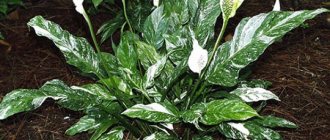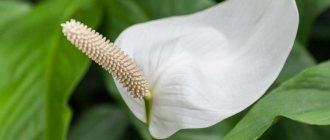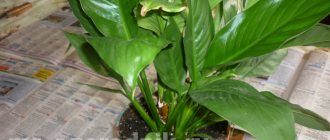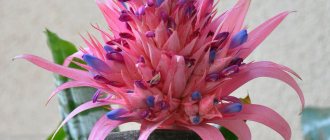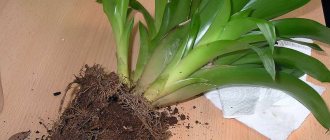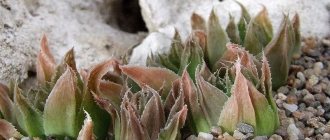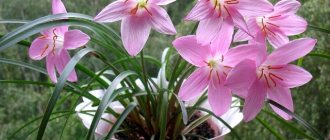How does spathiphyllum reproduce in natural conditions?
The flower has gained popularity due to its ease of care and beautiful appearance. If you like spathiphyllum, there should be no questions about how to propagate it; it’s worth seeing how it copes with it in natural conditions.
What does a spathiphyllum flower look like?
For your information! This plant grows best in swampy forests and on the shores of a warm lake or river. This is due to the fact that the plant loves a humid climate; even temperature is not such an important criterion. It reproduces by seed.
What determines the characteristics of reproduction at home?
Spathiphyllum has a special structure: the flower does not have a stem at all, so the leaves and flowers grow directly from the ground. Because of this, some types of reproduction are not available, and some care is also required.
A flower in a pot requires special conditions
You should pay attention to the growth of the flower in natural conditions. It does not like direct sunlight, but in the absence of light it may stop blooming. The air humidity should be high enough for the spathiphyllum to feel good. At the same time, it is worth watering the flower if the soil is completely dry, since otherwise the leaves will begin to rot at the base due to water retention.
Possible problems
Spathiphyllum does not bloom
There are several reasons for this. Problems with flowering are usually associated with low temperatures and insufficient humidity. Spathiphyllum will not bloom if it is not fed with mineral and organic fertilizers. In addition, old spathiphyllums bloom extremely rarely.
How to make Spathiphyllum bloom. What does “female happiness” need to bloom?
Leaves turn black
Blackness on the leaves indicates the death of the root system. Most often this problem is associated with improper watering. Leaves can turn black both with underwatering and with overwatering. Black leaves can also appear due to a lack of phosphorus and nitrogen. Remember that you cannot spray the plant in a cold room. To save the life of a flower, it should be removed from the pot and new roots should be removed, and then transplanted into a container with a new earthen substrate.
The leaves have turned yellow
Dried and yellowed tips of the leaves indicate underwatering. To eliminate this problem, the plant needs weekly bathing. This procedure will help cope not only with yellowness on the leaves, but also protect the flower from pests. If you haven't watered the plant for a long time, you can save it. But you shouldn’t fill the flower with water right away. After soaking the dry soil, increase the amount of water gradually. Spathiphyllum can also wilt if there is insufficient humidity. In this case, spraying and wiping the leaves will help. The plant can be placed in a tray with wet expanded clay. Yellowness may also appear if the flower is attacked by pests.
Pests
The main pests for spathiphyllum are spider mites and aphids. To get rid of them, the plant should be wiped with a soap solution containing nicotine sulfate. Only when treating against parasites should the soil cover be covered with a film, the liquid should not get into the soil. If you regularly wash and wipe the leaves of the plant with a damp sponge, you can forget about pests forever.
SPATHIPHYLLUM leaves turn black and dry ❖❖❖ Problems with Women’s Happiness and their solution
Step-by-step guide to propagation from cuttings
Spathiphyllum Domino flower - home care
When asked how easier it is to propagate spathiphyllum at home, flower growers answer - with cuttings. They are leaf rosettes that separate from the adult plant. If they have small roots, then they can be immediately planted in the soil, and if they are absent, you can get the root part yourself.
Reproduction of spathiphyllum by stems
From the stems
Taking a shoot from spathiphyllum is not so difficult: you need to carefully cut off the leaf rosette from the mother plant. The following steps should be followed:
- Place drainage at the bottom of an individual pot.
- Place the shoot containing the rhizome into the pot. In this case, you should carefully straighten the roots in the pot.
- It is recommended to hold the shoot while the substrate is poured into the pot.
- Pour water at room temperature.
Important! If the shoot does not have formed roots, you need to help the spathiphyllum acquire them. It doesn't require much effort, but success is guaranteed.
From leaves
Not everyone knows how spathiphyllum reproduces, so if you like this flower from friends or relatives, you should not ask for a leaf to germinate the plant at home. This propagation method is not suitable for this type of flower.
Further care of the plant
Since vegetative propagation produces almost full-fledged plants, further care for them does not differ from the creation of conditions for the mother plant, which were discussed above. Unless at first the planted plots need more abundant and frequent watering, as well as active spraying.
Sprouts grown from seeds require little more attention. In addition to the optimal humidity regime, they also need special temperature parameters, which are associated with the previous stay of the sprouts in greenhouse conditions. Before finally removing the glass or film covering over them, the seedlings must be hardened, gradually increasing the ventilation time of the improvised greenhouse. When the coating is finally removed, drafts should not be allowed near the pots with seedlings, which even adult spathiphyllums are afraid of.
How to germinate spathiphyllum shoots in water
Why does spathiphyllum not bloom at home?
It became clear how to take a spathiphyllum shoot, but nothing is clear about rooting. First you need to prepare the water in which the process will be carried out, since regular tap water will not work. Spathiphyllum requires a certain acidic habitat with a pH of 5 or 6.
Note! The secret to success is the use of activated carbon. It is this that needs to be crushed and added to water.
Rooting spathiphyllum in water
Rooting a shoot is not difficult: you need to place it in a container with water and coal and keep it there until roots appear. But subsequently it is required to plant it only in certain soil. The soil should be prepared from sphagnum, peat and perlite. It is also recommended to keep the new plant in a greenhouse until the cutting gets stronger. After this, it will be possible to transplant the flower to a permanent place.
Preparation for the propagation procedure (equipment, soil, container)
Before propagating spathiphyllum, prepare the necessary items and tools:
- sharpened, disinfected scissors, knife, pruning shears;
- ceramic or wooden containers;
- containers under water for temporary maintenance of cuttings;
- film or glass for organizing a mini-greenhouse.
The land for planting should be light and fertile. You can buy ready-made soil for flower crops or prepare it yourself. In the second case you will need:
- garden soil;
- peat or humus;
- small pieces of pine bark;
- charcoal;
- a little sand.
Young seedlings need containers that are not too large, otherwise they may not bloom. Spathiphyllum does not bloom until its roots entwine the entire space of the pot.
Note! Containers must have drain holes and a drainage pad made of expanded clay or pebbles. The drainage layer is sprinkled with sand on top
Instructions for growing from seeds
Spathiphyllum - home care
Propagation by spathiphyllum seeds is the most labor-intensive process. This event takes a lot of time and effort. It is recommended to purchase seeds for sowing at a specialized store. At the same time, it is worth paying attention to the expiration date: half of even fresh seeds may not sprout.
Obtaining flower seeds
Important! Spathiphyllum seeds quickly lose their similarity, so they need to be sown immediately after collection. To ripen, they will need to be pollinated by an adult flower that is in the flowering stage.
For sowing, use a small container (you can use a plate). It is recommended to mix the soil from sand and peat, taken in equal proportions. It is worth sowing in moist, but not wet soil, and place the container in a greenhouse. The greenhouse needs to maintain a temperature of about 25 °C. Watering is required using a spray bottle. When seedlings begin to appear, it is worth starting to ventilate from time to time, since excess moisture can contribute to the appearance of mold.
How to propagate the “female happiness” flower with seeds?
This method is quite difficult and breeders often use seed propagation to obtain a new variety.
It’s just that to propagate a plant this way it will be quite troublesome and take too long. After all, from planted seeds to a full-fledged flowering specimen, under good conditions, it takes two years, and often more.
Seed planting technology:
- Prepare a container with steamed soil and moisten it;
- If there are not many seeds, then they are laid out at a distance of 3 cm from each other. If there are a large number of seeds, then rows are made with a ruler, pressing it 0.5 cm into the moist soil;
- The container should be in a room where the temperature does not fall below 24 degrees Celsius. Lighting before sprouts appear is not very important;
- For better seed germination, cover the container with transparent glass or place it in a bag;
- At the time of growing seeds, it is necessary to monitor the humidity in the mini-greenhouse and ventilate it so that microbes that can cause a putrefactive process do not spread there;
- The sprouting of seedlings will begin at the moment when the sprouts have 2 pairs of true leaves.
Important! We must remember that in a greenhouse the soil dries out slowly, but as soon as the glass is removed, depending on the composition of the soil and the surrounding temperature, the soil will dry out 2-3 times faster.
How to properly divide spathiphyllum when transplanting
The easiest way to propagate a flower is by dividing the bush. But not everyone knows how to properly divide spathiphyllum when transplanting. For an adult plant, this action is useful, since in this way it is possible to remove a large number of young rosettes that take nutrients from the soil.
Replanting a flower requires a lot of space, since everything will be covered with soil.
It is recommended to carry out the process of dividing the mother bush in the spring, before the growing season begins. For good development, the delenka must have leaf rosettes. It is worth trying not to damage the root system too much. The root collar of a young plant should be at the same level as that of the mother.
Note! It is necessary to carefully select the size of an individual pot for the plant: in a large pot the root system will develop intensively, which will delay flowering. It is recommended to choose a medium-sized container so that not only the leaves develop.
Before starting the procedure, you need to water the plant generously to remove the flower along with a lump of earth. This will also help cause less damage to the root system. It is worth carefully rinsing the roots from the soil and untangling them. In this case, the separation will be easier to carry out. The cut areas need to be treated by sprinkling with charcoal or activated carbon and leaving to dry for a while.
It is recommended to purchase soil for planting aroid plants or mix it yourself. For this you will need:
- coarse river sand;
- peat;
- leaf soil;
- turf.
The rhizome of each division must be inspected and all dead parts removed. Each plant is planted in individual pots, spreading the fragile roots over the surface of the soil and carefully covering them with soil. Only after this is it necessary to carefully compact the soil.
You can mix the soil for spathiphyllum yourself
It is recommended to follow the step-by-step propagation instructions so that the flower subsequently takes root faster. But, if you like spathiphyllum, propagating the plant will bring joy, regardless of the complexity of the process.
XXI CENTURY Candy Fudge Scented water
266 ₽ More details
Video baby monitor Motorola MBP36S (white)
12900 ₽ More details
Aventurine beads
Types of spathiphyllum with photos and names
Spathiphyllum cannifolium
The birthplace of the flower is Venezuela and Thailand. The color of the ovoid leaves is rich green. The fragrant yellow-green cob is covered with a greenish-white blanket.
Spoon-shaped spathiphyllum (Spathiphyllum cochlearispathum)
In nature, the species is found in Brazil. The height of the bush is about 100 cm. The shiny elongated lanceolate leaf plates of a dark green color are up to 0.4 m long and up to 0.2 m wide, their edges are wavy. The petiole is about 0.7 m long. The inflorescence is a white spadix, which is covered with a long oval blanket.
Spathiphyllum floribundum
The species is native to Colombia. The height of the bush is about half a meter. The shape of the foliage is oval-lanceolate, its width is about 12 centimeters, and its length is up to 25 centimeters. The cob is covered with a white blanket.
Lovely spathiphyllum (Spathiphyllum blandum)
In nature, the species is found in tropical areas of America. The dark green leaf blades have an elongated lanceolate shape and a bent tip. The cob is covered with a white-greenish blanket. Since the cover of the flower is similar in appearance to a flag, the plant is also called a flagolite. A flowering bush develops several inflorescences. Flowering is observed from the second half of April to the beginning of June.
Spathiphyllum wallisii
The species is native to the tropical forests of Colombia. The height of the bush is about 0.3 m. The shape of the dark green foliage is oblong-lanceolate. The white cob is covered with a blanket that is longer than it. The color of the bedspread changes from white to green. Perfect for growing indoors, it has lush and long-lasting flowering.
Spathiphyllum heliconiifolium
In the wild it is found in the tropical rainforests of Brazil. The height of the bush is about 100 cm. The dark green shiny leaf plates are up to 25 cm wide and up to 50 cm long, their shape is elongated-elliptical, slightly pointed at the top, and the edge is wavy. The length of the petiole is slightly less than 100 cm. The inflorescence reaches a length of 10 centimeters; it is an open flower, the color of which goes from white to almost black. The width of the oval blanket is about 10 centimeters, and the length is up to 15 centimeters. Grows quite well indoors.
Varieties of Spathiphyllum. The most popular varieties of “female happiness”.
Depending on flowering: before, during flowering and after
The main flowering period for spathiphyllum is from March to September. In winter, the plant blooms rarely, gaining strength. Young individuals begin to bloom in the second year of life.
Before flowering, fertilizing is used in the form of preparations with potassium and phosphorus.
During this period, it is important to maintain the normal immunity of the flower, strengthening its protective function.
During flowering, it is necessary to provide the plant with warmth; do not take the flower pot outside and avoid drafts. Blooming spathiphyllum cannot be replanted.
After flowering ends, the plant is prepared for hibernation.
The flower is removed from all the old peduncles, leaving 2-3 cm from the rhizome. The plant is moved to a cool place and the watering and spraying regime is changed up to twice a week.
general description
The oval leaves of the plant with a pointed end grow from the ground; many species lack a stem. Cuttings with foliage from 15 cm to 1.5 m in height grow from the rhizome. The purpose of spring flowering is to attract insects for pollination and seed development. Sometimes the process is observed repeatedly throughout the year. In the plant world of the tropics and subtropics, spathiphyllum is located on the lower tier. He has no tolerance to bright sunlight. In its complete absence, the flowering period may be halved.
Spathiphyllum in its natural habitat
The plant does well in the shade and prefers diffused light. When bright direct rays fall on it, the leaves fade and dry out. Based on this pattern, a north, west or east window is chosen to place the crop in the house.
Spathiphyllum appeared in Europe towards the end of the 19th century, when it was brought from the jungles of America. The discoverer is considered to be the German researcher G. Wallis, after whom one of the varieties is named.
Leaf planting
Sooner or later you will want to increase your plantation of these beautiful plants. First of all, we will warn those who have not grown spathiphyllum before from making mistakes. It cannot reproduce by leaf.
We invite you to familiarize yourself with the Level: what it is and what such a device is like, classification and principle of operation
Unlike, for example, begonia, a spathiphyllum leaf dipped in water will simply rot without giving roots. The same thing will happen if you immediately stick it into the ground, as is done with many succulents. Flower growers practice propagation of spathiphyllum by cuttings or division of rhizomes.
It is, of course, possible to use seeds, but it is complicated by many factors, which will be discussed below.
Features of planting children
First of all, when propagating a plant, you need to have the necessary soil on hand.
Since in its homeland the flower grows in fallen leaves and rotting branches with a small amount of charcoal, you should have similar soil on hand at home.
You can purchase soil for orchids and add a little deciduous soil, or immediately purchase soil for Aroids.
We must not forget that the soil must be loose and allow water to pass through well, feeding the root system.
The container where the flower is planted must be precisely selected according to the root system, since spathiphyllum will not bloom in a large pot until the roots have completely entwined the lump of earth.
Also, in a large pot it is possible to flood the roots of the flower, and as a result, rot on the roots.
Important! The flower must be planted so that the root collar is at the same level.
